AmpliTube vs Guitar Rig: which amp and effects modelling plugin is best?
Want loads of tones at your fingertips but can't decide between IK Multimedia’s AmpliTube 5 or Native Instruments Guitar Rig 6? Let us help you choose
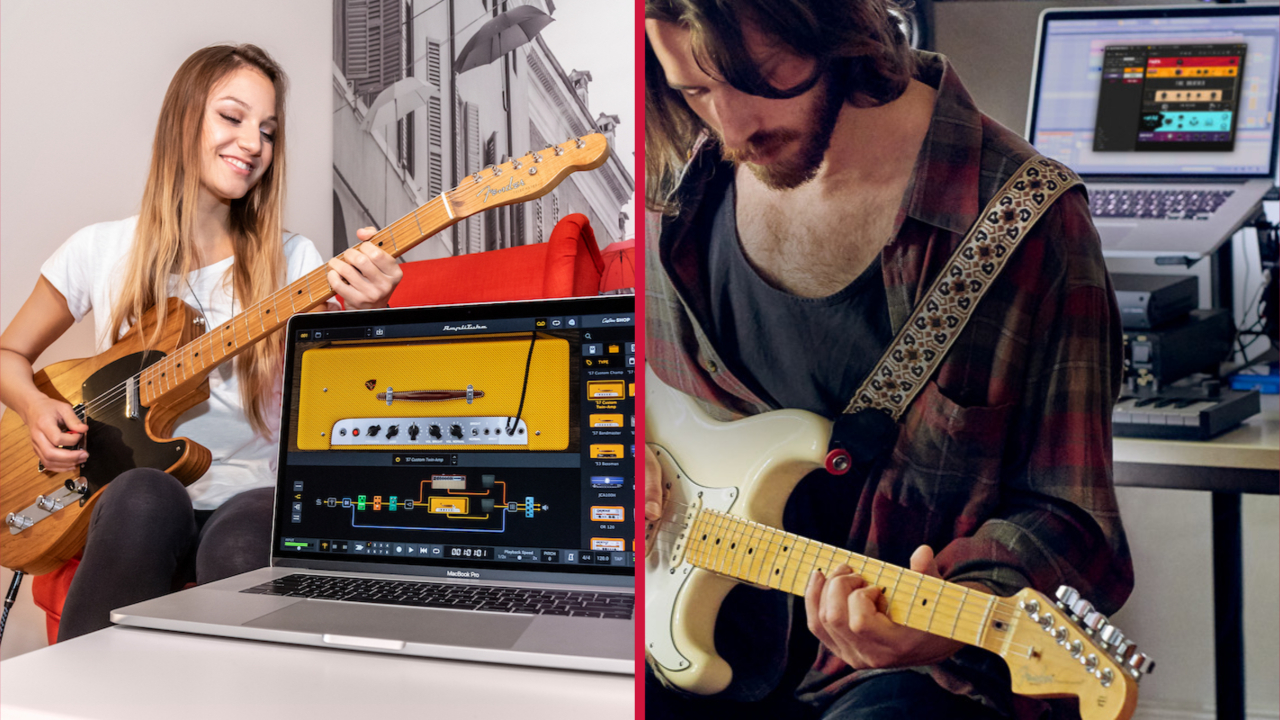
Describing AmpliTube and Guitar Rig as amp and effects modelling software is woefully inadequate. Sure, when AmpliTube arrived on the scene two decades ago, quickly followed by Guitar Rig, this was an apt description but both guitar plugins have since evolved into something so much more.
Both are still a fun way to play about with software approximations of amps and effects that, in the real physical world, are simply unaffordable for many of us, and there’s nothing wrong with that, particularly not right now when we’re all tightening our belts. However, AmpliTube and Guitar Rig have matured into software programs that don’t just give hardware a run for its money, in many instances they sprint ahead before dancing a cheeky victory celebration.
If you’re forever going to be satisfied with the sound of a Tele plugged straight into a good ol’ tube amp – tonal heaven for us too, by the way – then by all means stick with hardware. But, if you enjoy experimentation, sound design, complex routings or the joy of discovering something original, then AmpliTube and Guitar Rig hold huge appeal. But when it comes to AmpliTube vs Guitar Rig, which should you choose? Let’s find out.
- Explore more of the best guitar VSTs
AmpliTube vs Guitar Rig: At a glance
AmpliTube 5
- Price: AmpliTube CS, free; AmpliTube SE, $149.99/€149.99; standard edition AmpliTube, $299.99/€299.99; AmpliTube MAX, $599.99/€599.99
- System requirements: AmpliTube is a 64-bit application and requires a 64-bit CPU and Operating System
- It works as a standalone application for Windows and MacOS, or as a DAW plugin (AU, VST 2, VST 3, AAX)
- Buy AmpliTube 5 at IK Multimedia
Guitar Rig 6
- Price: Guitar Rig Player, free; Guitar Rig Pro, $199.99/£179.99
- System requirements: System requirements:Guitar Rig is a 64-bit application and requires a 64-bit CPU and Operating System.
- It works as a standalone application for Windows and MacOS, or as a DAW plugin (AU, VST, AAX)
- Buy Guitar Rig 6 at Native Instruments
Both packages are modelling software programs primarily for guitar, but you can experiment with any input type including synths and vocals.
IK Multimedia AmpliTube 5 is available in four versions. AmpliTube CS is free and includes 42 essential amps and effects to get you started. AmpliTube SE is a step up, giving you 80 pieces of gear for a modest $149.99/€149.99. The standard edition of AmpliTube costs substantially more at $299.99/€299.99 but it does include over 170 pieces of kit. You can add additional individual pieces of gear within AmpliTube, or buy larger custom bundles from IK’s online store, as and when you need (or can afford) them.
Alternatively, you can invest in AmpliTube MAX, the full-fat version for $599.99/€599.99. It includes every conceivable option – more than 400 gear models, including 11 brand/artist collections.
Native Instruments Guitar Rig 6 is available in two versions. Guitar Rig Player features a British-style tube amp and matched cabinet, plus 13 effects and tools. It’s totally free. Guitar Rig Pro is the all-in version, with more than 100 amps and effects. It costs $199.99/£179.99.
Get The Pick Newsletter
All the latest guitar news, interviews, lessons, reviews, deals and more, direct to your inbox!
In order for us to review all the available features, we’re going to pitch AmpliTube 5 MAX head-to-head with Guitar Rig 6 Pro. We will, however, remain mindful that Guitar Rig costs significantly less.
AmpliTube vs Guitar Rig: Features
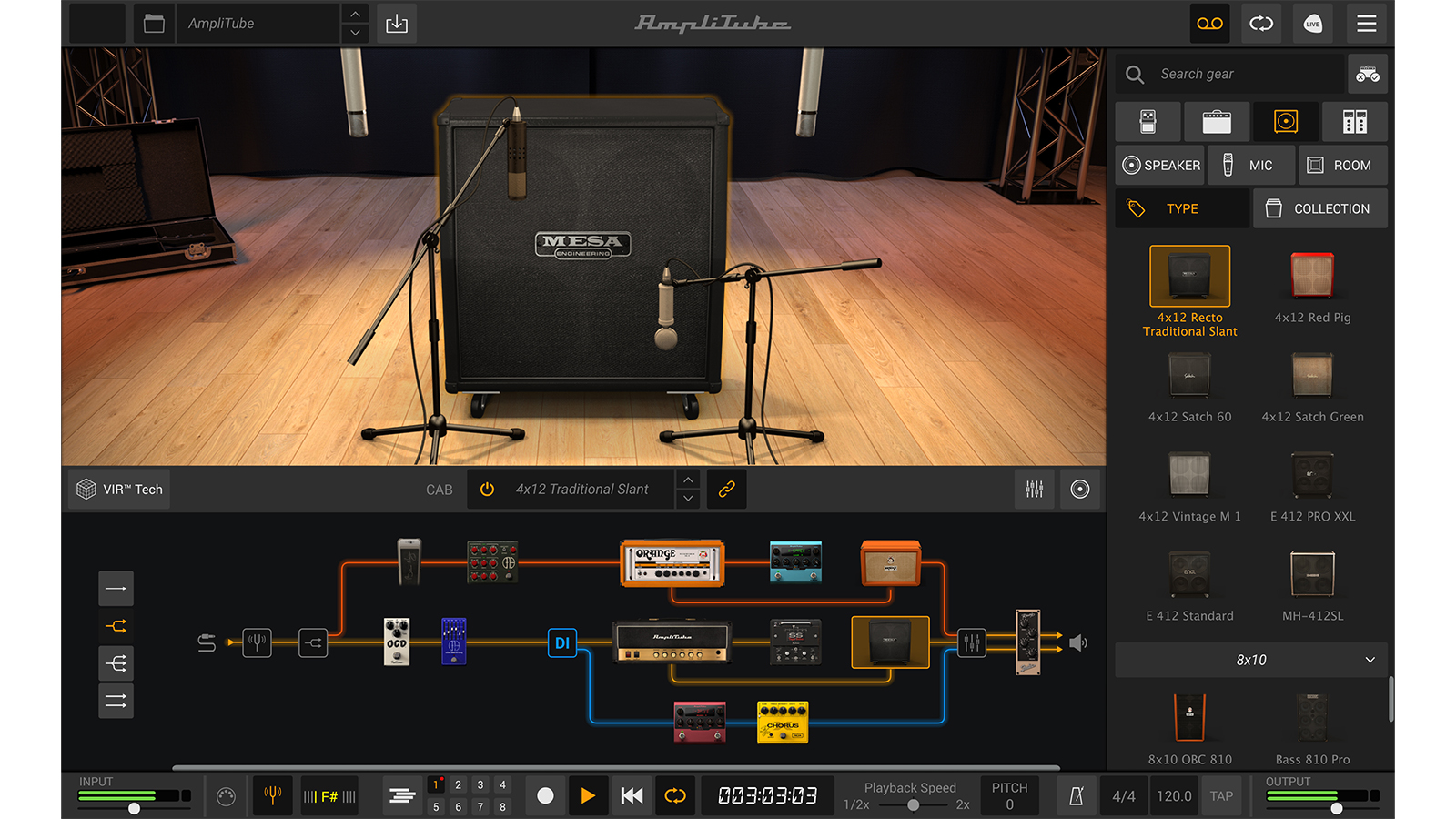
AmpliTube 5 MAX is a complete tonal solution for your guitar, or any other instrument for that matter, including your voice. It features a staggering amount of modelled gear, including amplifiers, cabs, speakers, mics and effects boxes. Life gets really interesting when you start routing this kit together in ways that would be almost impossible in a physical studio or performance space.
AmpliTube also includes an 8-track recorder, looper, tuner and other DAW-like features that make recording or live performance as efficient as possible. Just add talent.
Guitar Rig 6 Pro has a lower feature count than AmpliTube, but don’t dismiss it because of that – after all, bigger isn’t necessarily better. It also includes amplifiers, cabs, mics, effects and a very malleable routing system. It’s not quite as capable on the recording and performance side, but is slightly stronger on new, less traditional effects.
Where Guitar Rig teases us with equipment names that hint at the gear being modelled – Plex (Marshall) and hot solo (soldano), for example – AmpliTube is more upfront. IK Multimedia has worked with brands such as Fender, Mesa Boogie, Orange and more, to bring fully endorsed modelled versions of their iconic amps and effects.
Winner: It’s a given that AmpliTube offers more of just about everything, but it also delivers fully endorsed models and signature presets from the likes of Mesa/Boogie, Slash, Brian May…
AmpliTube vs Guitar Rig: UI and ease of use

To build a rig in AmpliTube you just drag a piece of gear on to a virtual signal path, just like daisy chaining a real setup together. The chain can be a simple single path, a two-way split (mono into stereo), a three-way split or parallel, the latter being useful for stereo instruments such as synths. FX loops and a DI path can be utilized, plus up to about 50 items of gear (each path differs slightly in this respect), so it’s possible to build some impressively complex rigs very quickly and easily.
AmpliTube uses hyper-realistic skeuomorphic graphic interpretations of every piece of gear in its huge library. Which is a long winded way of saying that a Fender ’65 Twin Reverb in AmpliTube looks just like a 2D version of the real thing. This makes it easy to find your way around the controls, the Volume’s where it should be, as is the Treble, Middle, Bass, Reverb and so on. Same goes for the stompboxes. The downside is that, pretty though they are, these graphics take up a large amount of screen real estate.
Finding a suitable piece of kit to load into your chain is simply a case of searching for it by name, or browsing by stompbox, amp, speaker, rack, type or collection. Despite the potentially overwhelming choice of gear, the comprehensive search tools make selecting the right piece of kit quick and easy.
Guitar Rig works slightly differently. Instead of dragging gear, aka Components, to a virtual chain, you position it in the program’s rack-like main window. You can then drag a component up or down to set its order in the signal path.
Input can be set as either left, stereo or right and it’s surprisingly easy to consolidate multiple effects or create sophisticated effect chains using Splitter tools such as Split Mix, Freq Crossover, and M/S Balance.
Just like AmpliTube, it’s easy to hunt for a specific piece of gear to add to your rig. To an extent, Guitar Rig also uses graphic interpretations of familiar kit, but it doesn’t stick rigidly to ‘50s style chicken head knobs and the like, which makes its contemporary UI much slicker.
Both programs feature scores of pre-built chain presets that can be loaded and then tweaked to your heart’s content. It’s a great way to get a taste of the vast sound design opportunities available to you.
Winner: AmpliTube’s signal chain looks and reacts just like the real thing, but the rest of the package is a little dark and uninspiring. Guitar Rig, with its bright, contemporary design, is easier to get to grips with.
AmpliTube vs Guitar Rig: Deeper features
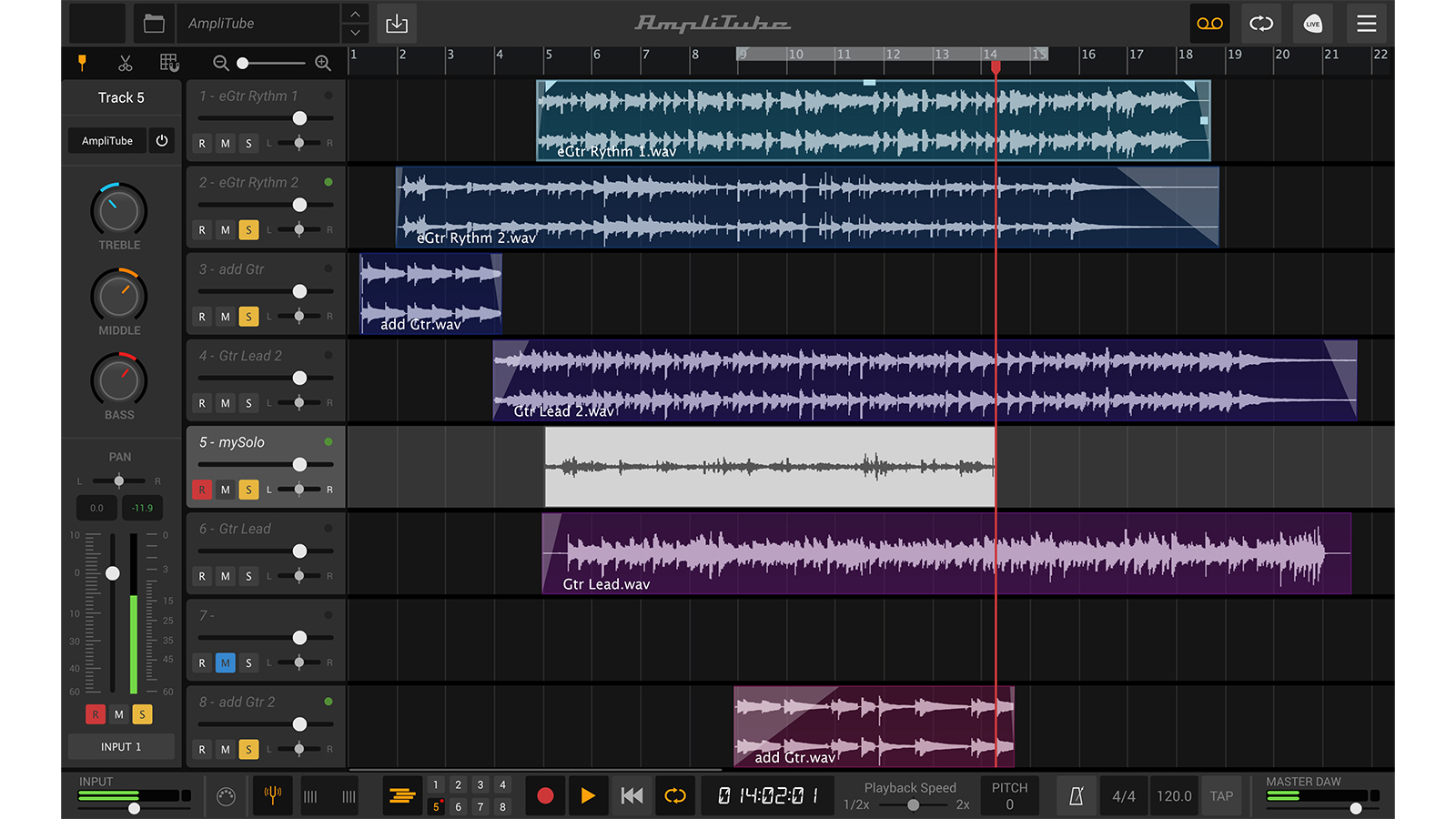
Guitar Rig can record both your input and output, but AmpliTube is leaps and bounds ahead of the game with its DAW-like eight-track recorder and mixer environment. It also boasts a fully featured looper and Live Mode, which integrates with IK Multimedia’s iRig Stomp I/O pedalboard and AXE I/O interface hardware. Its Live Mode GUI is also big, bright and bold, perfect to be seen from a distance.
Both AmpliTube and Guitar Rig feature extensive MIDI support that allows you to map control changes to parameters and commands. Hooking up to a hardware controller is a common, basic example of how MIDI can be leveraged to your advantage, but you can get as adventurous as you like. Just imagine connecting a bunch of hardware and software MIDI enabled devices to these feature rich environments, the possibilities are infinite.
Automation is also well supported, and straightforward to implement in both packages. This enables you to take advantage of the advanced automation capabilities of modern DAWs, something that would be impossible with a physical ‘50’s Tweed amp!
Winner: Their MIDI and automation features make AmpliTube and Guitar Rig immensely powerful solutions for both recording and live performance. However, AmpliTube’s DAW-like eight-track recorder makes it an incredibly versatile standalone production tool. AmpliTube takes it.
AmpliTube vs Guitar Rig: Sounds/tone
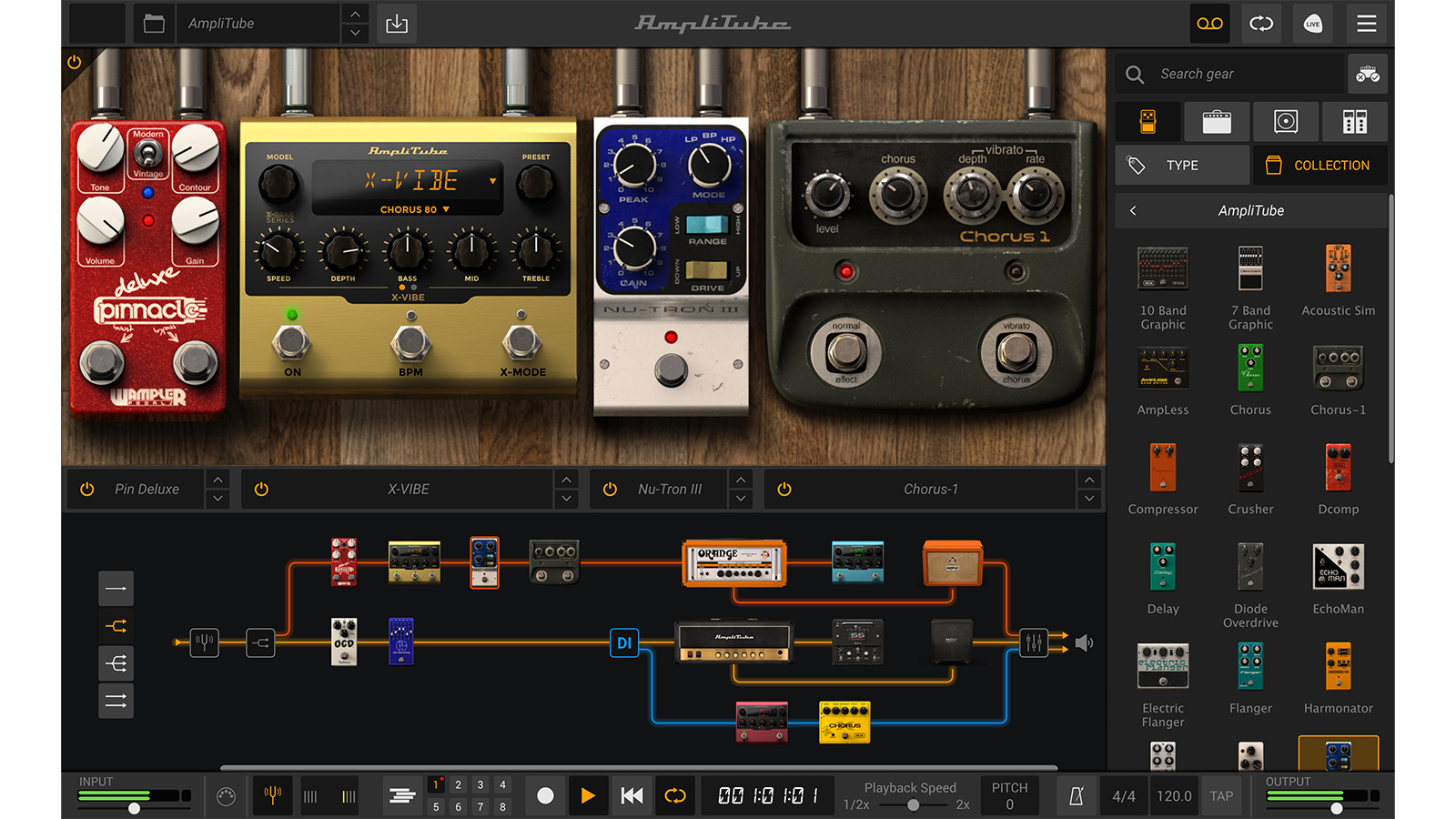
Back in the early days, amp and effects modellers always sounded remarkable until the gain was cranked up, at which point they’d develop more fizz than a two-litre bottle of Coke rolling around in the trunk of a hot cab.
Fortunately, those times have gone. Both AmpliTube and Guitar Rig can muster some truly gorgeous tones from a wide variety of models, but which is better?
By naming some big brands in its gear library the more ambitious, and expensive, AmpliTube sets itself up for some potentially awkward direct comparisons. Does its Dual Rectifier model roar like a ‘proper’ Mesa/Boogie Dual Rectifier? Does the E650 crunch like an ENGL E650 Head? Does the '57 Custom Deluxe sparkle like a real ‘50s Fender?
Well, these are just a few of AmpliTube’s large number of approved models, officially certified by their respective brands as being truly representative. In short, you won’t hear better, and to our ears they sounded very close.
Both AmpliTube and Guitar Rig can muster some truly gorgeous tones from a wide variety of models
But does it really matter? Does anybody really care about getting a precise match to an iconic piece of kit when, if they’re honest, what they’re genuinely after is something that sounds extraordinary, regardless of brand?
This is the approach favoured for Guitar Rig, almost certainly for licensing reasons, but it has some merit. What its amps lack in authenticity they make up for in tone. Take the gorgeous ‘Chicago’, a simple 50’s inspired amp with just a single volume and a single tone control. Whichever way you choose to spin those knobs it sounds glorious, from sparkly Fenderish cleans to saturated bliss. Does it matter that it doesn’t feature the spidery Fender script? Nah, of course not.
Guitar Rig also scores highly for its arsenal of modern effects, raided from its Komplete catalogue. The Raum reverb sounds sublime, otherworldly in fact, and as good as anything from Valhalla. It’s also armed with contemporary sounding bit-crushing, distortion, frequency shifting, modulation and compression effects. Yes, AmpliTube covers this ground too, but Guitar Rig’s implementation is so much better.
When Native Instruments launched Guitar Rig 6 a couple of years ago it proudly mentioned its new Intelligent Circuit Modelling (ICM) technology. Initially, only a small number of amps featured ICM and unfortunately Native Instrument’s plans to roll out more have been hampered by Covid.
IK Multimedia has been championing its component level Dynamic Interaction Modelling (DIM) technology for a while now, but more recently it’s developed Volumetric Impulse Response (VIR) for AmpliTube too. VIR captures more than 600 impulses per speaker (up to 2,400 per cabinet), letting you move microphones around in 3D for the ultimate placement. It even captures the bleed and interaction of nearby speakers in a multi-speaker cabinet, along with floor reflections. Guitar Rig can’t touch this level of realism.
Winner: We really rate Guitar Rig for its vintage and contemporary tones, and its ease of use. If, however, you value a specific amp or stomp box and are very particular about mic placement only AmpliTube will do.
AmpliTube vs Guitar Rig: Verdict
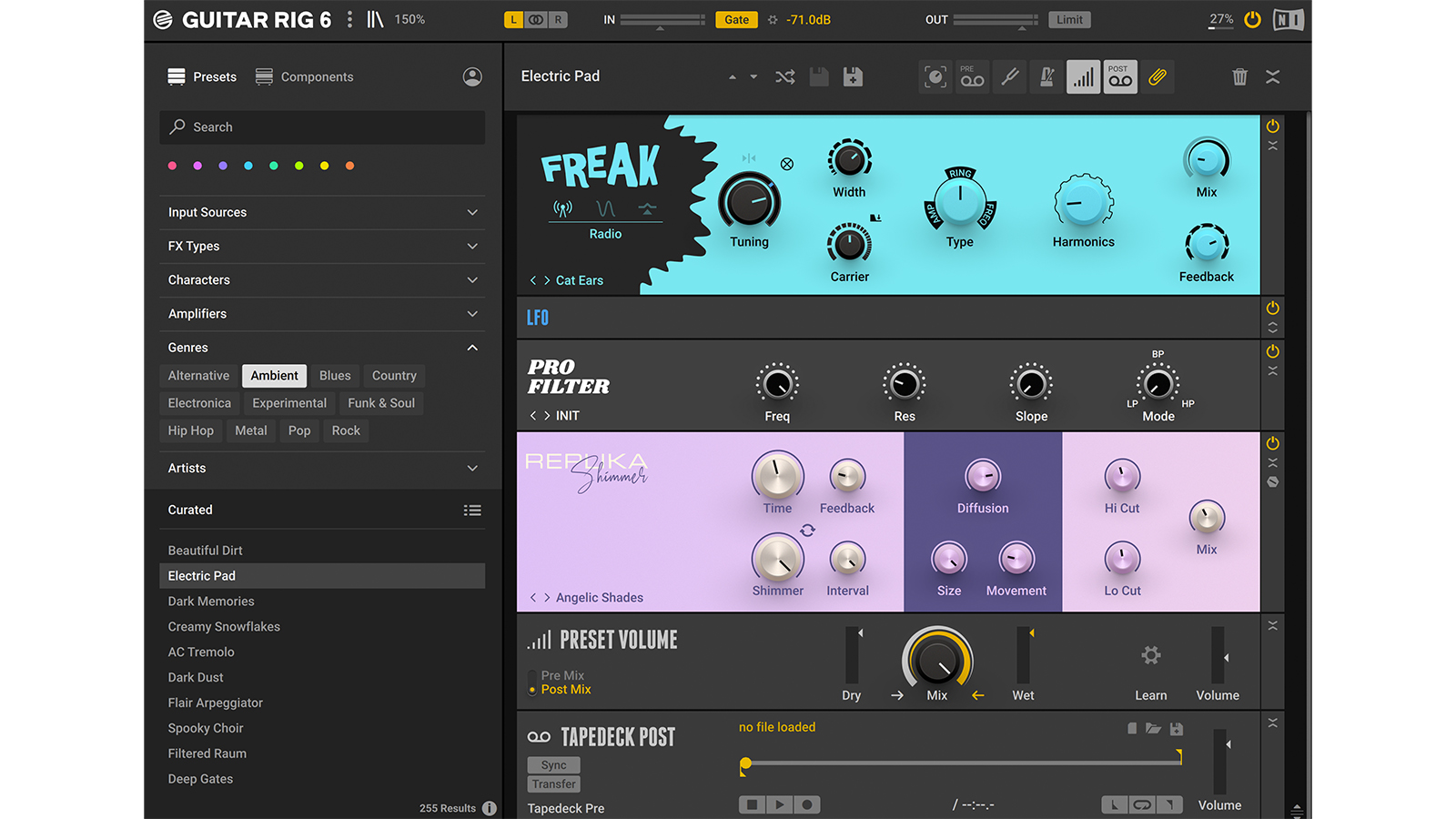
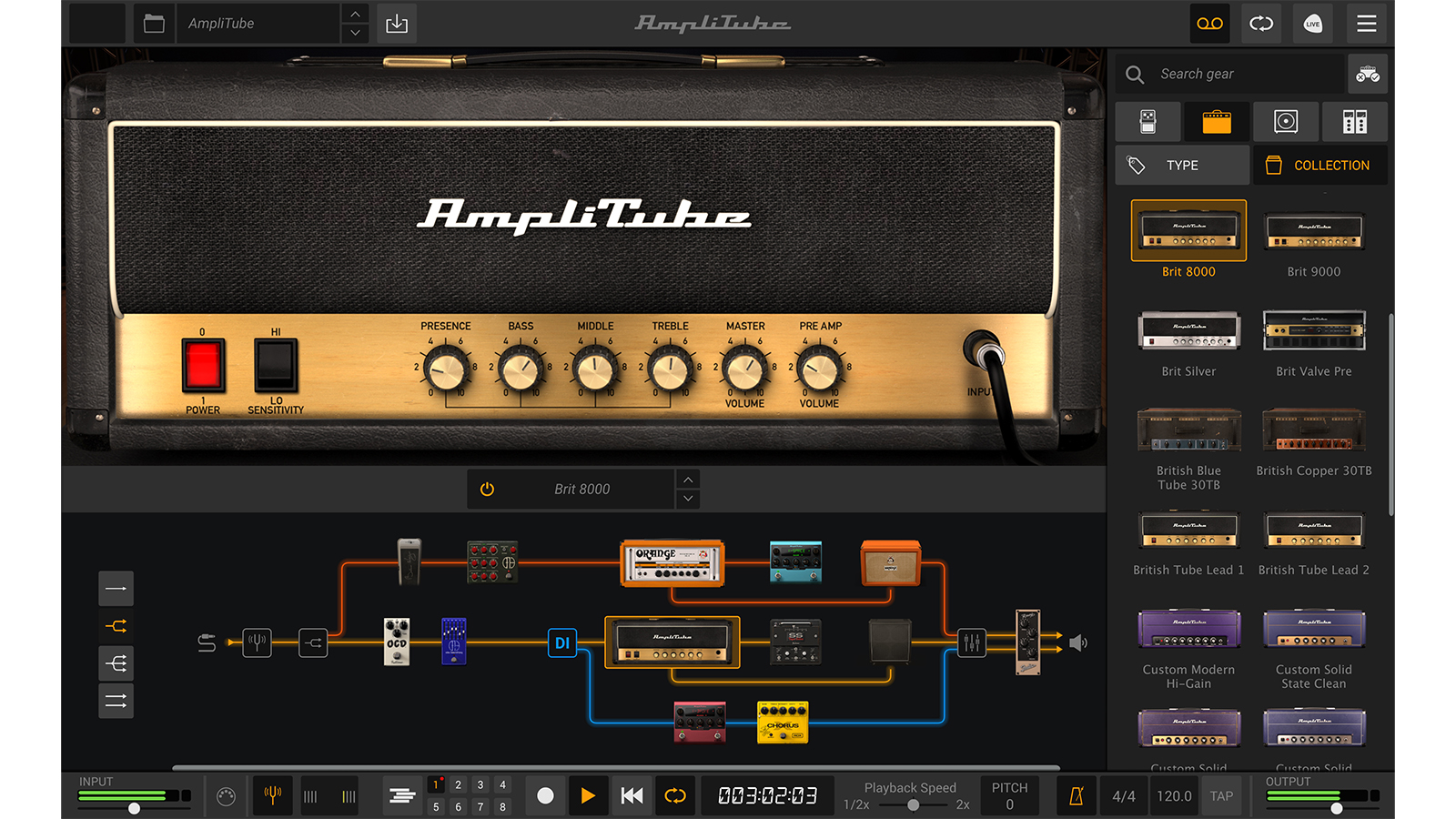
Neither Guitar Rig nor AmpliTube will disappoint, both have matured into immensely powerful suites of software that would take years to fully explore. More importantly, they sound wonderful.
Guitar Rig is the less expensive of the two but we’re not going to smear it as the cheap ‘n cheerful option – it’s far too accomplished to deserve that. Yes, it offers fewer amps and effects but tonally they’re all first class. What’s more, the rack-inspired UI is a joy to use, making it easy to get up and running very quickly, even with potentially complex routings.
Right across the board, from amp to compressor, every control is immediate and there’s plenty of visual feedback to help you realise your target tone. Effects and production tools reach well beyond the obvious vintage guitar stompboxes – there’s a whole gamut of sonic goodness to play with from modern tone-shaping effects to multi-step envelopes, LFOs and sequencers.
Ultimately though, AmpliTube just has more of just about everything. It has the officially sanctioned big name amplifiers, it has component level modelling and it has incredibly accurate speaker IRs. It matches Guitar Rig effect for effect, and then adds a whole lot more. How much more? Well, there’s a manual dedicated just to the amps and effects that stretches to 530 pages.
Routing is straightforward, not least because the onscreen representation of a signal chain looks just like the real thing. In fact, everything looks authentic, which isn’t always a good thing because in my opinion it wastes a lot of space.
Finally, AmpliTube’s DAW-like 8-track recorder moves the program into new territory, a land where Guitar Rig just cannot compete. If you value a modern UI and are working in contemporary genres then Guitar Rig deserves a close look. For traditionalists – a sizable proportion of the guitarist market – AmpliTube is impossible to resist.
Latest offers
When Simon's childhood classical guitar teacher boasted he 'enjoyed a challenge', the poor man had no idea how much he'd underestimated the scale of the task ahead. Despite Simon's lack of talent, the experience did spark a lifelong passion for music. His classical guitar was discarded for an electric, then a room full of electrics before Simon discovered the joys of keys. Against all odds, Simon somehow managed to blag a career as a fashion journalist, but he's now more suitably employed writing for Guitar World and MusicRadar. When not writing or playing, he can be found terrifying himself on his mountain bike.

![A black-and-white action shot of Sergeant Thunderhoof perform live: [from left] Mark Sayer, Dan Flitcroft, Jim Camp and Josh Gallop](https://cdn.mos.cms.futurecdn.net/am3UhJbsxAE239XRRZ8zC8.jpg)









